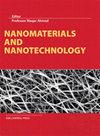Characterization of Bismuth Composited to Carbon Nanotube-Coated Titanium Cathode in Electro-Fenton System
IF 3.3
3区 材料科学
Q2 MATERIALS SCIENCE, MULTIDISCIPLINARY
引用次数: 0
Abstract
Bismuth (Bi) is a highly reactive catalyst for the generation of hydroxyl (∙OH) radicals. Cathodes constructed from composites of Bi and carbon nanotube (CNT) exhibit high stability and low resistance, which enhance their electron transfer capability. In this work, a titanium substrate was coated with multi-walled carbon nanotube (MWCNT/Ti) using electrophoretic deposition process, followed by electrodeposition of Bi onto the MWCNT-coated Ti (Bi/MWCNT/Ti). The effects of Bi electrodeposition time on the surface morphology of Bi/MWCNT/Ti cathodes were investigated by scanning electron microscopy and energy-dispersive X-ray spectroscopy, and the electrochemical characteristics of each cathode were identified via a series of electrochemical analyses further. The results demonstrated that electrodeposition at −0.85 V vs. Ag/AgCl for 5 min revealed uniform distribution of dense Bi across the surface of cathode, which provides better hydrophilicity for cathode and promotes highest electron transfer rates, respectively; when the Bi/MWCNT/Ti cathode was used as an electro-Fenton (EF) cathode, the EF system achieved a rhodamine B degradation rate of 80.8% after 30 min, which is a significant increase (83.63%) than the unmodified Ti cathode. The use of Bi in EF cathodes improves the efficiency of the EF process.电fenton体系中铋复合碳纳米管-钛阴极的表征
铋(Bi)是生成羟基(∙OH)自由基的高活性催化剂。由铋和碳纳米管(CNT)复合材料构建的阴极具有高稳定性和低电阻,增强了其电子传递能力。在本研究中,采用电泳沉积工艺在钛基体上涂覆多壁碳纳米管(MWCNT/Ti),然后在MWCNT涂层上电沉积Bi (Bi/MWCNT/Ti)。采用扫描电镜和能量色散x射线能谱研究了Bi电沉积时间对Bi/MWCNT/Ti阴极表面形貌的影响,并通过一系列电化学分析进一步鉴定了各阴极的电化学特性。结果表明:在−0.85 V vs. Ag/AgCl条件下电沉积5 min,阴极表面致密Bi分布均匀,具有较好的亲水性和较高的电子转移率;当Bi/MWCNT/Ti阴极作为电fenton (EF)阴极时,EF体系在30 min后的罗丹明B降解率为80.8%,比未改性的Ti阴极显著提高(83.63%)。在电解阴极中使用铋提高了电解过程的效率。
本文章由计算机程序翻译,如有差异,请以英文原文为准。
求助全文
约1分钟内获得全文
求助全文
来源期刊

Nanomaterials and Nanotechnology
NANOSCIENCE & NANOTECHNOLOGY-MATERIALS SCIENCE, MULTIDISCIPLINARY
CiteScore
7.20
自引率
21.60%
发文量
13
审稿时长
15 weeks
期刊介绍:
Nanomaterials and Nanotechnology is a JCR ranked, peer-reviewed open access journal addressed to a cross-disciplinary readership including scientists, researchers and professionals in both academia and industry with an interest in nanoscience and nanotechnology. The scope comprises (but is not limited to) the fundamental aspects and applications of nanoscience and nanotechnology
 求助内容:
求助内容: 应助结果提醒方式:
应助结果提醒方式:


